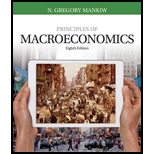
Principles of Macroeconomics (MindTap Course List)
8th Edition
ISBN: 9781305971509
Author: N. Gregory Mankiw
Publisher: Cengage Learning
expand_more
expand_more
format_list_bulleted
Question
Chapter 1, Problem 3PA
To determine
Analysis of opportunity cost .
Expert Solution & Answer
Trending nowThis is a popular solution!

Students have asked these similar questions
Graph shows the daily market price of jeans when the tax on sellers is set to zero per pair supposed the government institutes attacks of $20.30 per pair to be paid by the seller what is the quantity after tax
How do you figure out tax incidents in elasticity
not use ai please
Chapter 1 Solutions
Principles of Macroeconomics (MindTap Course List)
Ch. 1.1 - Prob. 1QQCh. 1.2 - Prob. 2QQCh. 1.3 - Prob. 3QQCh. 1 - Prob. 1CQQCh. 1 - Prob. 2CQQCh. 1 - Prob. 3CQQCh. 1 - Prob. 4CQQCh. 1 - Prob. 5CQQCh. 1 - Prob. 6CQQCh. 1 - Prob. 1QR
Ch. 1 - Prob. 2QRCh. 1 - Prob. 3QRCh. 1 - Prob. 4QRCh. 1 - Prob. 5QRCh. 1 - Prob. 6QRCh. 1 - Prob. 7QRCh. 1 - Prob. 8QRCh. 1 - Prob. 9QRCh. 1 - Prob. 10QRCh. 1 - Prob. 1PACh. 1 - Prob. 2PACh. 1 - Prob. 3PACh. 1 - Prob. 4PACh. 1 - Prob. 5PACh. 1 - Prob. 6PACh. 1 - Prob. 7PACh. 1 - Prob. 8PACh. 1 - Prob. 9PACh. 1 - Prob. 10PACh. 1 - Prob. 11PA
Knowledge Booster
Similar questions
- Not use ai pleasearrow_forwardHelp me write these economic analysis for Macys one paragraph) Company name/current state of operation of this company - Describe the company's performance in the present economy, whether it is growing or declining, and who are its competitors?arrow_forwardnot use ai pleasearrow_forward
arrow_back_ios
SEE MORE QUESTIONS
arrow_forward_ios
Recommended textbooks for you
 Economics Today and Tomorrow, Student EditionEconomicsISBN:9780078747663Author:McGraw-HillPublisher:Glencoe/McGraw-Hill School Pub Co
Economics Today and Tomorrow, Student EditionEconomicsISBN:9780078747663Author:McGraw-HillPublisher:Glencoe/McGraw-Hill School Pub Co Economics (MindTap Course List)EconomicsISBN:9781337617383Author:Roger A. ArnoldPublisher:Cengage Learning
Economics (MindTap Course List)EconomicsISBN:9781337617383Author:Roger A. ArnoldPublisher:Cengage Learning

 Microeconomics: Private and Public Choice (MindTa...EconomicsISBN:9781305506893Author:James D. Gwartney, Richard L. Stroup, Russell S. Sobel, David A. MacphersonPublisher:Cengage Learning
Microeconomics: Private and Public Choice (MindTa...EconomicsISBN:9781305506893Author:James D. Gwartney, Richard L. Stroup, Russell S. Sobel, David A. MacphersonPublisher:Cengage Learning Economics: Private and Public Choice (MindTap Cou...EconomicsISBN:9781305506725Author:James D. Gwartney, Richard L. Stroup, Russell S. Sobel, David A. MacphersonPublisher:Cengage Learning
Economics: Private and Public Choice (MindTap Cou...EconomicsISBN:9781305506725Author:James D. Gwartney, Richard L. Stroup, Russell S. Sobel, David A. MacphersonPublisher:Cengage Learning

Economics Today and Tomorrow, Student Edition
Economics
ISBN:9780078747663
Author:McGraw-Hill
Publisher:Glencoe/McGraw-Hill School Pub Co

Economics (MindTap Course List)
Economics
ISBN:9781337617383
Author:Roger A. Arnold
Publisher:Cengage Learning



Microeconomics: Private and Public Choice (MindTa...
Economics
ISBN:9781305506893
Author:James D. Gwartney, Richard L. Stroup, Russell S. Sobel, David A. Macpherson
Publisher:Cengage Learning

Economics: Private and Public Choice (MindTap Cou...
Economics
ISBN:9781305506725
Author:James D. Gwartney, Richard L. Stroup, Russell S. Sobel, David A. Macpherson
Publisher:Cengage Learning